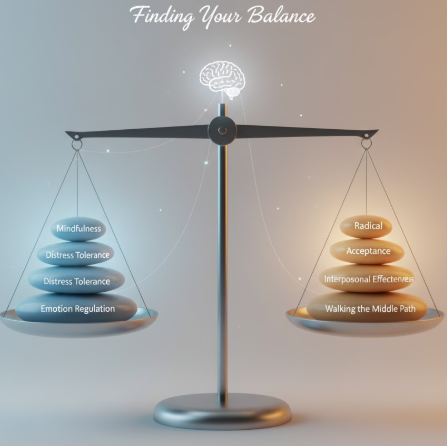Boundaries or Avoidance? How to Tell the Difference
We talk a lot about boundaries these days, and for good reason. But sometimes what we call a “boundary” is actually a wall. A wall built out of self-protection, not self-awareness.
I see this often with clients (and, let’s be honest, in my own life too). Boundaries are essential for emotional well-being, but avoidance can wear the same outfit. It can look like “protecting your peace” when really, you’re trying not to feel something uncomfortable.
The truth is, healthy boundaries make room for connection. Avoidance closes the door.
When Boundaries Turn Into Walls
Many of us were never taught how to set boundaries in a healthy way. We either learned to overextend ourselves to keep the peace or to withdraw completely to stay safe.
So when we start learning about boundaries as adults, it’s easy to swing to extremes. Suddenly, everything that drains us becomes “toxic.” Every discomfort feels like a red flag. And while it’s valid to protect your energy, it’s also worth asking:
Am I setting this boundary because it honors me ? Or because it helps me avoid discomfort?
In Dialectical Behavior Therapy (DBT), there’s a term called dialectics - holding two truths at once. For example:
“I need space” and “I want connection.”
“I’m protecting myself” and “I’m also scared of being hurt again.”
Both can be true.
What DBT Teaches Us About Boundaries
DBT teaches that boundaries are about balance, not all or nothing. It’s not cutting people off to stay in control, and it’s not over-accommodating to keep the peace.
Healthy boundaries come from a place of regulation and clarity. Avoidance, on the other hand, usually comes from fear or overwhelm.
Here’s what that difference can look like in real life:
Boundary: “I care about you, and I need some time to process before we talk.”
Avoidance: “I’m blocking them because I don’t know how to handle conflict.”
Boundary: “I can’t make it tonight, but I’d love to reschedule when I have more energy.”
Avoidance: “I’ll just cancel and say I’m busy so I don’t have to deal with it.”
See the pattern? Boundaries communicate. Avoidance disconnects.
If you’re noticing how hard it can be to tell the difference between boundaries and avoidance, that’s okay. Therapy can help you build skills to set limits that protect your peace and your connections.
Signs It Might Be Avoidance, Not a Boundary
You feel relief in the moment, but guilt or isolation later.
You don’t actually communicate your needs - you disappear.
The choice feels reactive instead of intentional.
The “boundary” keeps you stuck, not safe.
It’s rooted in fear (“I’ll get hurt”) rather than values (“I need peace”).
Avoidance often gives you short-term relief but long-term loneliness. Boundaries, when done well, may feel uncomfortable at first, but they build deeper trust - both with yourself and others.
How to Create Boundaries Without Disconnecting
Boundaries aren’t meant to push people away. They’re meant to teach people how to be close to you safely.
Here are a few ways to practice that balance:
🌿 Pause before you pull away. Ask yourself, “Am I protecting peace, or avoiding pain?”
🌿 Regulate before you communicate. Take a few deep breaths or use a grounding skill before setting a limit.
🌿 Be honest, even if it’s awkward. “I need space” lands better than silence.
🌿 Start small. You don’t have to overhaul your boundaries overnight. Pick one relationship and practice there.
🌿 Hold compassion for yourself. Avoidance is a learned protection strategy. You can unlearn it without shame.
Final Thoughts
Boundaries aren’t about walls - they’re about doors. The goal isn’t to shut people out, but to decide who gets access, when, and how.
Avoidance may keep you safe, but it also keeps you lonely. Real growth happens in the tension between space and connection - the messy middle where we learn that we can protect our peace and still let people in.
If you’ve been struggling to find that balance, therapy can help you get curious about what your boundaries are protecting - and whether they’re still serving you.
Ready to find that middle ground?




